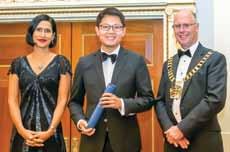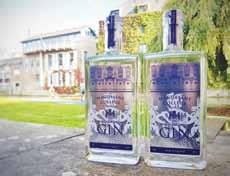
3 minute read
Nuclear Powerhouse
By Mr Adrian Bull (1980)
I never consciously decided to work in the nuclear industry. My late father worked as a nuclear design engineer in the sector from its very early years in the early 1950s, which is how I got involved.
Advertisement
Through his contacts, I learned about the industry and somehow secured sponsorship from British Nuclear Fuels Limited (BNFL) when I came up to Magdalene to read Engineering in 1980. It sounded like ‘free money’. As finals neared, I was offered a job interview by BNFL and willingly took the job they offered so I could concentrate on my studies, figuring I could always look for another employer after a few months. Some 35 years later, I’m still in the industry, although BNFL is no more.

Mr Adrian Bull with his MBE.
In the same way I didn’t consciously enter the nuclear industry, I didn’t consciously decide to put engineering behind me. I began work in 1983 in a very technical role, using my engineering degree in what was then the emerging field of computer simulation. After a few years, I broadened out, getting involved in a wider range of science projects and found that the part of my job I liked the most was discussing and explaining the scientific work to people who were not themselves scientists – either within the company or outside. Gradually I took on more work which involved the communication of nuclear science, which in turn led to working on submissions to policy consultations on nuclear and energy matters – of which there were many in the early 2000s – and sometimes giving evidence to select committees and suchlike.
As the policy debate about nuclear continued, there was a demand for industry ‘experts’ to engage with all sorts of groups to explain the benefits of the industry and discuss the issues around nuclear waste, radiation, safety and the reactor accidents at Chernobyl and – more recently – Fukushima. I found myself increasingly invited to speak at events from school careers fairs to party conference debates, via trade union committees, local councils and the Women’s Institute (who were one of the best-informed and challenging groups I ever met). Many a Friday night was spent driving home from a meeting somewhere in the country following a lively debate on some aspect of the nuclear sector. (Incidentally, I think they’ve had that ‘free money’ back many times over…!)
After 23 years with BNFL, I left in 2006 to join Westinghouse, a nuclear fuel and reactor company, looking after UK stakeholder relations. Six years later, I joined the UK’s National Nuclear Laboratory as External Relations Director. More senior roles, involvement in various industry committees, as well as some industry-wide work on how best to engage with the public on complex scientific topics such as nuclear, gave me a certain level of visibility in Government and I think that must have led to my nomination for the MBE (for services to the development of public understanding in nuclear research), which came as a total surprise at the end of 2017. I’m not often speechless, but I was when I opened that particular envelope!
The day itself was very special and – thankfully – sunny. Having watched many royal events (and The Crown on TV!) it was so humbling to walk up the steps into Buckingham Palace and then through the various state rooms to the Ballroom and an anxious wait to be called out to collect the award from HRH The Princess Royal. She could not have been lovelier and, while the details of the conversation itself are a bit of a blur, she was knowledgeable and attentive throughout – and for everyone else enjoying their special day.
A friend of mine who has an OBE described receiving his honour as “a piece of typically British bonkers-ness”. He’s right – but we do that sort of thing so well, and it was a genuine privilege to be part of it.
www.magd.cam.ac.uk










